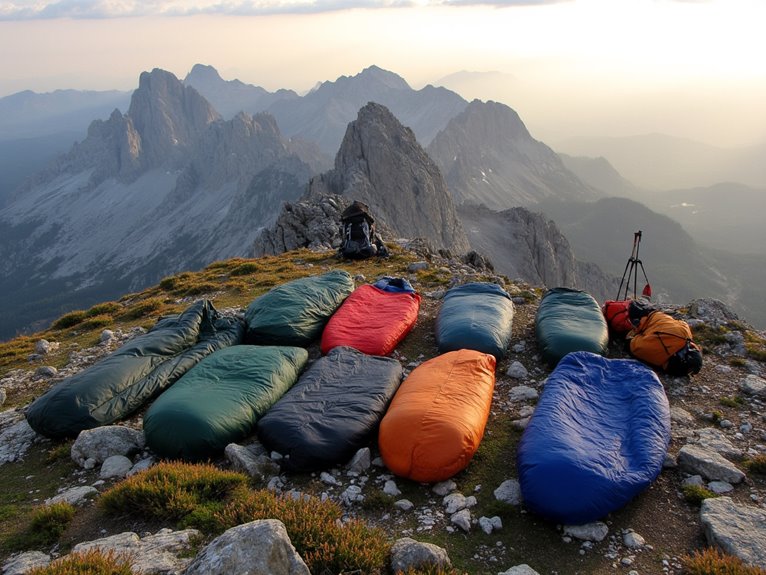10 Best Sleeping Bags for Thru-Hiking That Won’t Weigh You Down
For thru-hiking, I recommend ultralight sleeping bags under 2 pounds that won’t destroy your shoulders by mile 500. The ECOOPRO Warm Weather bag weighs just 1.7 pounds and handles 55-60°F temperatures, while the Hyke & Byke Eolus 0°F model weighs 3.36 pounds with 800 fill-power down for cold conditions. TANSTRIDER’s 1.6-pound option offers excellent compressibility at 13.39 inches packed. Choose down insulation for weight savings or synthetic for wet climates. Below, I’ll break down specific temperature ratings and compression specs for each model.
We are supported by our audience. When you purchase through links on our site, we may earn an affiliate commission, at no extra cost for you. Learn more. Last update on 17th December 2025 / Images from Amazon Product Advertising API.
Notable Insights
- Ultralight sleeping bags under 2 pounds are essential for thru-hiking, with top options weighing 1.5-1.7 pounds for extended trips.
- Down insulation offers superior warmth-to-weight ratio and compressibility, making it ideal for cold weather thru-hiking applications.
- Temperature ratings should match trail conditions: 15°F bags for mountains, 55-60°F bags for warmer coastal or desert routes.
- Compression size matters significantly; look for bags that pack down to 8-12 liters or 6-13 inches in height.
- Mummy bag designs provide better warmth-to-weight efficiency than rectangular bags, though they offer less movement space.
ECOOPRO Warm Weather Sleeping Bag – Portable, Waterproof & Lightweight

The ECOOPRO Warm Weather Sleeping Bag delivers exceptional portability at just 1.7 pounds, making it an ideal choice for thru-hikers who prioritize ultralight gear without sacrificing comfort. You’ll appreciate its envelope design measuring 83L x 30W inches, providing adequate space for most adults while packing down to just 11 inches in height.
This bag’s nylon outer shell offers waterproof protection against light precipitation, though you shouldn’t rely on it during heavy downpours. The 100% polyester lining guarantees breathability in its best temperature range of 55-60°F. With 4.4 stars from over 8,000 reviews, it ranks #4 in camping sleeping bags, proving its reliability for warm-weather thru-hiking adventures.
Best For: Ultralight backpackers and thru-hikers who need a compact, lightweight sleeping solution for warm weather camping in temperatures between 55-60°F.
Pros:
- Exceptionally lightweight at only 1.7 pounds and packs down to just 11 inches, ideal for ultralight backpacking
- Waterproof nylon outer shell with breathable polyester lining provides comfort in warm weather conditions
- Strong customer satisfaction with 4.4/5 stars from over 8,000 reviews and ranked #4 in camping sleeping bags
Cons:
- Limited waterproofing that only protects against light drizzle, not suitable for heavy rain
- Not suitable for cold weather use, requiring temperatures above 50°F for adequate warmth
- May be too narrow for people with broader shoulders and zippers can be prone to snagging
3-4 Seasons Lightweight Waterproof Sleeping Bag with Compression Sack

Budget-conscious hikers seeking a versatile sleeping system will find this 3-4 seasons polyester sleeping bag delivers solid performance without breaking the bank. The 290T polyester construction measures 33 x 86.6 inches and weighs approximately 4 pounds. You’ll appreciate the waterproof double-layer technology that prevents dampness in wet conditions while maintaining warmth near freezing temperatures.
The compression sack makes transport manageable, though the 4-pound weight isn’t ultralight by thru-hiking standards. You can zip two bags together or open it completely as a blanket for versatility. Customer ratings average 4.5 stars from 7,514 reviews, ranking #8 in camping sleeping bags. While zippers occasionally snag, they function smoothly when properly maintained.
Best For: Budget-conscious campers and car campers who need a versatile, waterproof sleeping bag for 3-season use and don’t mind carrying extra weight.
Pros:
- Waterproof double-layer technology keeps you dry and warm in wet conditions down to near-freezing temperatures
- Versatile design allows zipping two bags together or opening completely as a blanket
- Excellent value with high customer satisfaction (4.5 stars from over 7,500 reviews) and machine washable convenience
Cons:
- At 4 pounds, it’s too heavy for ultralight backpacking or thru-hiking
- Zippers occasionally snag and require proper maintenance to function smoothly
- Large packed size makes it less ideal for space-conscious backpackers
Hyke & Byke Eolus 0°F Cold Weather Mummy Sleeping Bag
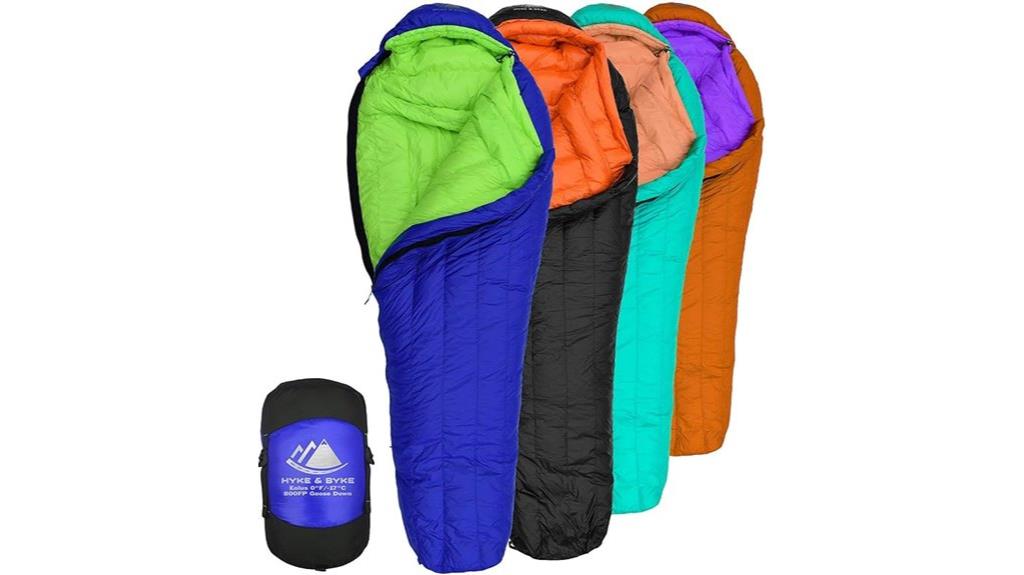
Cold-weather adventurers seeking ultralight warmth will find their match in the Hyke & Byke Eolus 0°F Mummy Sleeping Bag. This sleeping bag weighs just 3.36 pounds in long size while delivering 800 fill-power goose down insulation. You’ll stay warm in temperatures ranging from 0°F to 30°F.
The bag features 400T 20D ripstop nylon with DWR coating and vertical baffles for adjustable insulation distribution. Two large YKK zippers with anti-snag sliders provide easy access. You’ll appreciate the roomy footbox design that accommodates users up to 6’6″. Side sleepers benefit from the spacious interior that allows natural movement.
Customer reviews average 4.4 out of 5 stars across 1,148 ratings, with users confirming warmth performance down to 20°F.
Best For: Cold-weather backpackers and thru-hikers who prioritize ultralight gear without sacrificing warmth in temperatures down to 0°F.
Pros:
- Ultralight at 3.36 lbs with high-quality 800 fill-power goose down insulation
- Roomy design with spacious footbox that accommodates users up to 6’6″ and allows comfortable side sleeping
- Durable construction with ripstop nylon, DWR coating, and dual YKK zippers with anti-snag sliders
Cons:
- Less insulation on the backside may create cold spots when sleeping on the ground
- May require additional layers for comfort in extreme conditions near the 0°F rating
- Mummy design may feel restrictive for some users despite the roomy footbox
Naturehike Lightweight Sleeping Bag – Compact & Ultralight for 3 Season Camping
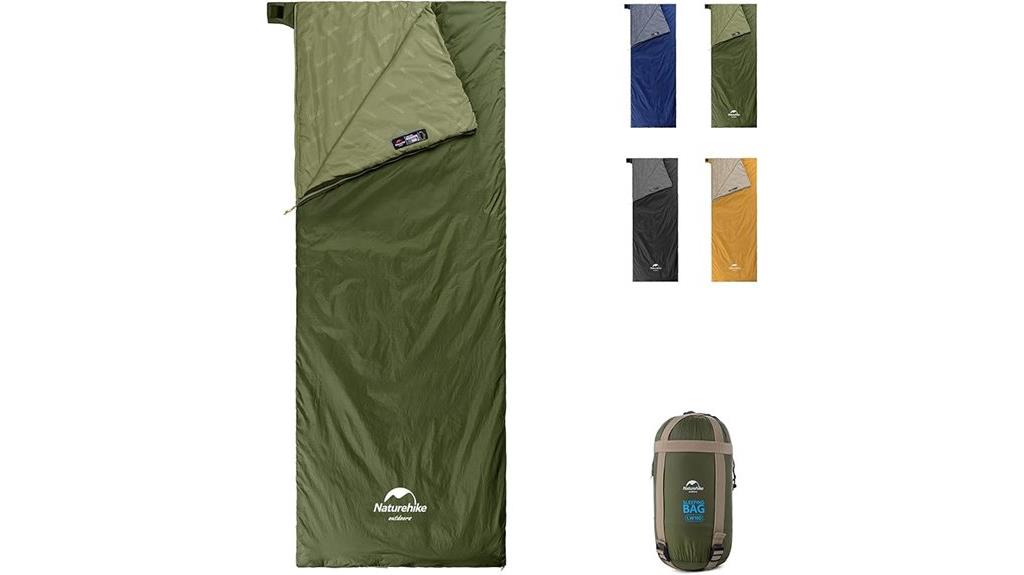
The Naturehike Lightweight Sleeping Bag delivers exceptional portability for summer thru-hikers who prioritize pack weight reduction above all else. You’ll get a compact package weighing just 28 ounces that compresses to Nalgene bottle size. The bag features waterproof exterior materials and quality zippers. However, you can’t rely on manufacturer temperature ratings. Real-world performance shows comfort limits above 60°F, with inadequate warmth below 55°F. You’ll need additional insulation for temperatures approaching 40°F. The bag accommodates side sleepers around 6’0″ and 175 pounds comfortably. It’s ideal for summer sections and warm-weather hiking, but you shouldn’t depend on it for shoulder seasons or high-altitude segments.
Best For: Summer thru-hikers and warm-weather backpackers who prioritize ultralight pack weight and need a compact sleeping solution for temperatures above 60°F.
Pros:
- Extremely lightweight at 28 ounces and compresses to Nalgene bottle size for maximum portability
- Quality construction with waterproof exterior materials and reliable zippers
- Comfortable for side sleepers around 6’0″ and 175 pounds with good roominess and loft
Cons:
- Temperature ratings are unreliable – inadequate warmth below 55-60°F despite manufacturer claims
- Requires additional insulation layers for temperatures approaching 40°F
- Not suitable for shoulder seasons, high-altitude camping, or three-season use as advertised
Ultralight Warm Weather Sleeping Bag with Compression Sack
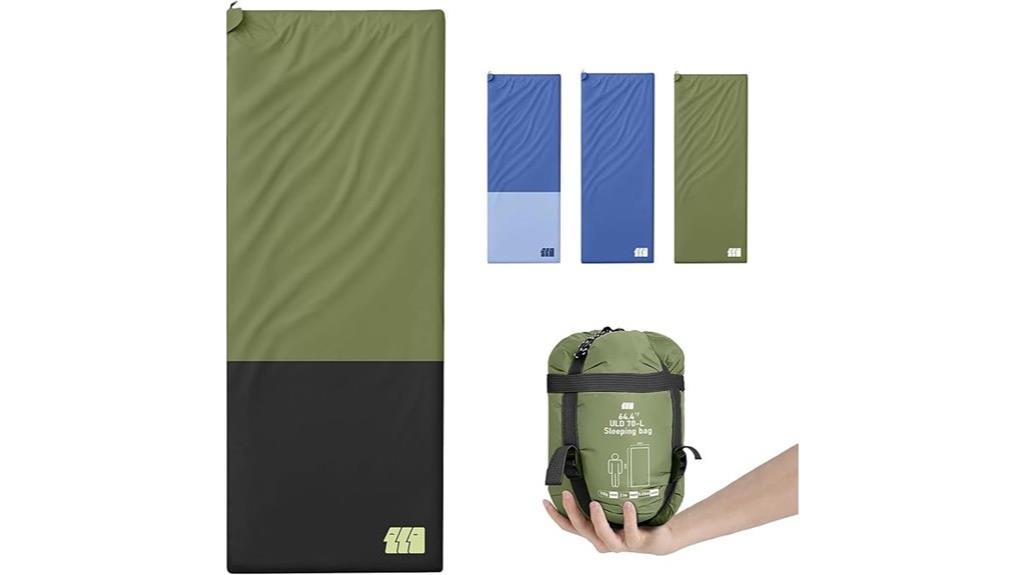
TANSTRIDER’s Ultralight Warm Weather Sleeping Bag delivers exceptional portability for anyone who prioritizes weight reduction without sacrificing comfort on extended trail journeys. At just 1.6 pounds, this rectangular sleeping bag measures 82.7 by 31.5 inches and handles temperatures from 50 to 70 degrees Fahrenheit effectively.
You’ll appreciate the two-way zipper system that connects with another bag or converts into a quilt. The durable nylon exterior and breathable cotton lining provide reliable protection. Foot zippers enhance ventilation during warmer nights.
The included compression sack reduces packed dimensions to 13.39 by 7.05 by 4.53 inches, maximizing your backpack space efficiently.
Best For: Ultralight backpackers, hikers, and campers who need a compact, warm-weather sleeping solution for temperatures between 50-70°F and want the versatility to connect bags or use as a quilt.
Pros:
- Extremely lightweight at 1.6 pounds with excellent compressibility for backpack space optimization
- Versatile two-way zipper system allows bag connection and quilt conversion functionality
- Foot zippers provide additional ventilation control for temperature regulation
Cons:
- Limited temperature range (50-70°F) restricts use to warm weather conditions only
- Rectangular shape may be less thermally efficient than mummy-style designs
- Cotton lining may retain moisture and take longer to dry compared to synthetic materials
Down Sleeping Bag for Adults 0°F-20°F Cold Weather Backpacking
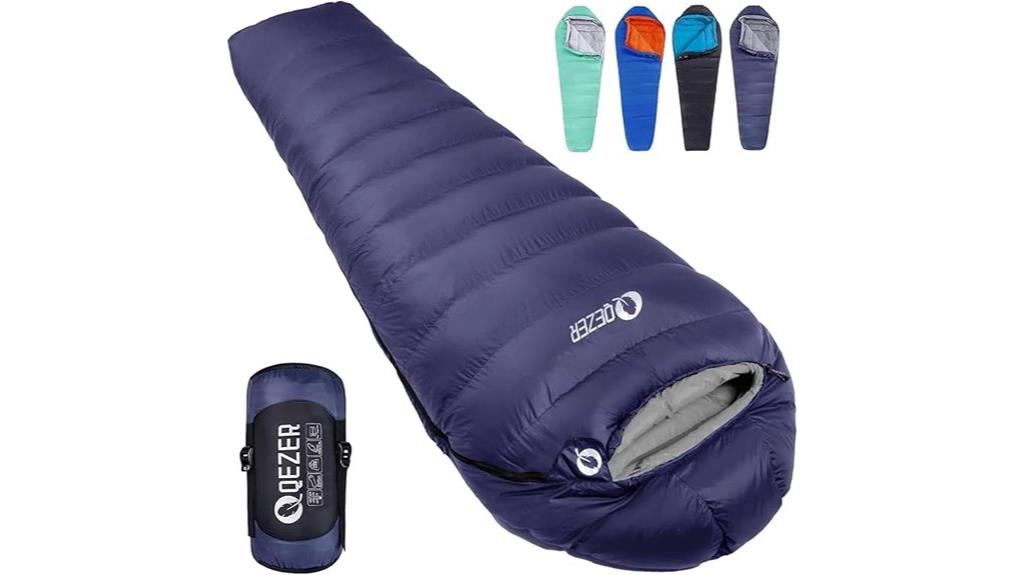
When nighttime temperatures plummet to bone-chilling levels, the QEZER Down Sleeping Bag stands out as a cold-weather specialist designed for thru-hikers who refuse to compromise on warmth or packability. At 2.65 pounds, it delivers exceptional warmth-to-weight ratio through 1.1 pounds of 600 fill power duck down insulation.
You’ll appreciate its mummy design with trapezoidal bottom for extra legroom while maintaining thermal efficiency. The 400T 20D nylon shell resists tears and wind penetration. With dual zippers and insulated flaps, cold spots won’t compromise your sleep.
The bag compresses to 13.8 x 6.7 inches using the included compression sack—essential for extended backcountry trips where space matters.
Best For: Serious backpackers and thru-hikers who need a lightweight, compressible sleeping bag for cold weather conditions down to 15°F while prioritizing warmth-to-weight ratio.
Pros:
- Excellent warmth-to-weight ratio at 2.65 lbs with 600 fill power duck down insulation
- Highly compressible design (13.8 x 6.7 inches) ideal for extended backcountry trips
- Durable construction with tear-resistant 400T 20D nylon shell and insulated zipper flaps
Cons:
- Some users report concerns about zipper quality and durability
- Drawstring design receives mixed feedback from customers
- May not perform reliably at the advertised 0°F rating based on user experiences
Hyke & Byke Quandary 15°F Cold Weather Mummy Sleeping Bag
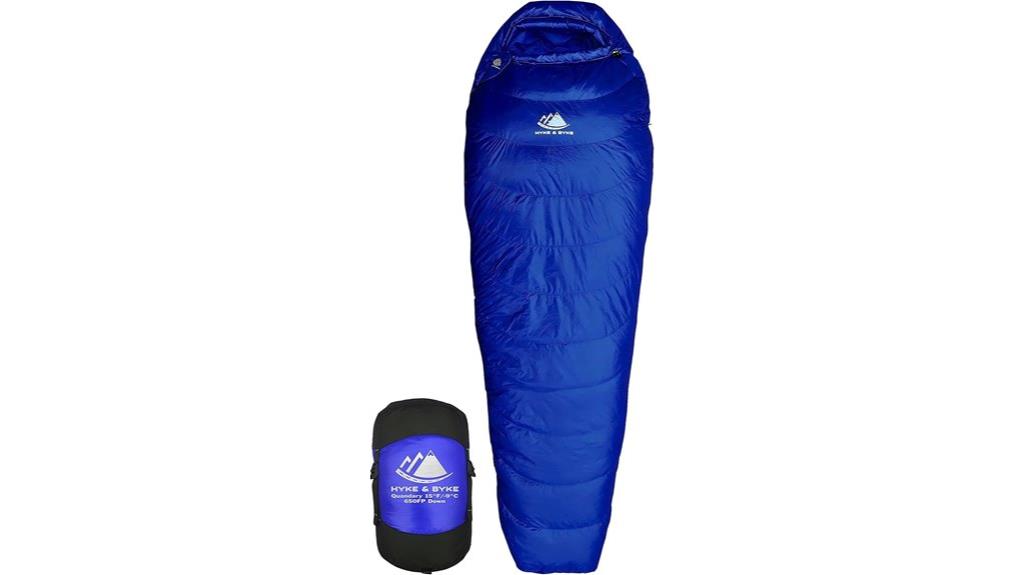
Cold-weather thru-hikers seeking reliable warmth without sacrificing pack weight will find the Hyke & Byke Quandary 15°F an exceptional choice for shoulder season and winter adventures. The 650 fill power duck down insulation delivers warmth at just 2.89 pounds. You’ll stay comfortable around 30°F, with survival capability down to 15°F.
The bag’s horizontal baffle construction prevents cold spots while enabling fill redistribution. Measuring 78″ long with 28″ shoulder width in regular size, it accommodates most hikers comfortably. Superior YKK zippers resist water and snags. The 400T 20D ripstop shell features DWR coating for moisture protection. Compression to 11″ x 7.5″ dimensions maximizes pack space efficiency for extended trail journeys.
Best For: Cold-weather thru-hikers and winter campers who need reliable warmth down to 15°F while maintaining a lightweight, compact pack setup.
Pros:
- Excellent warmth-to-weight ratio at 2.89 lbs with 650 fill power duck down insulation
- Superior compression capability (11″ x 7.5″) maximizes pack space for extended trips
- High-quality construction with YKK zippers, ripstop shell, and horizontal baffle design prevents cold spots
Cons:
- Some users report occasional zipper issues despite anti-snag features
- Duck down loses insulating properties when wet, requiring careful moisture management
- Mummy design may feel restrictive for sleepers who prefer more room to move
Warm Weather Sleeping Bag – Portable Waterproof Compact Lightweight for Camping

The WERTYCITY Warm Weather Sleeping Bag delivers exceptional portability for thru-hikers who prioritize ultralight gear without sacrificing comfort in temperate conditions. Weighing just 1.54 pounds, this bag compresses to 6.9 inches in your pack. You’ll appreciate the 75L x 29.5W inch dimensions that accommodate most body types. The nylon exterior and polyester pongee lining provide durability and breathability. It’s rated for 59°F comfort temperatures, making it ideal for spring through fall hiking. Two bags zip together for shared warmth. The compression sack streamlines packing. You’re getting proven performance with 4.4 stars from over 1,300 reviews.
Best For: Thru-hikers, backpackers, and campers who need an ultralight sleeping bag for warm weather conditions in spring, summer, and fall.
Pros:
- Extremely lightweight at just 1.54 pounds and compresses to only 6.9 inches for minimal pack space
- Two sleeping bags can zip together to create a double bag for couples or shared warmth
- Breathable nylon exterior with soft polyester pongee lining provides comfort and durability
Cons:
- Limited to warm weather use only with 59°F comfort rating, not suitable for cold conditions
- Customer feedback indicates some concerns about zipper durability over time
- May be too small for larger individuals despite 75L x 29.5W inch dimensions
OneTigris Bushcrafter’s Mummy Sleeping Bag for Camping
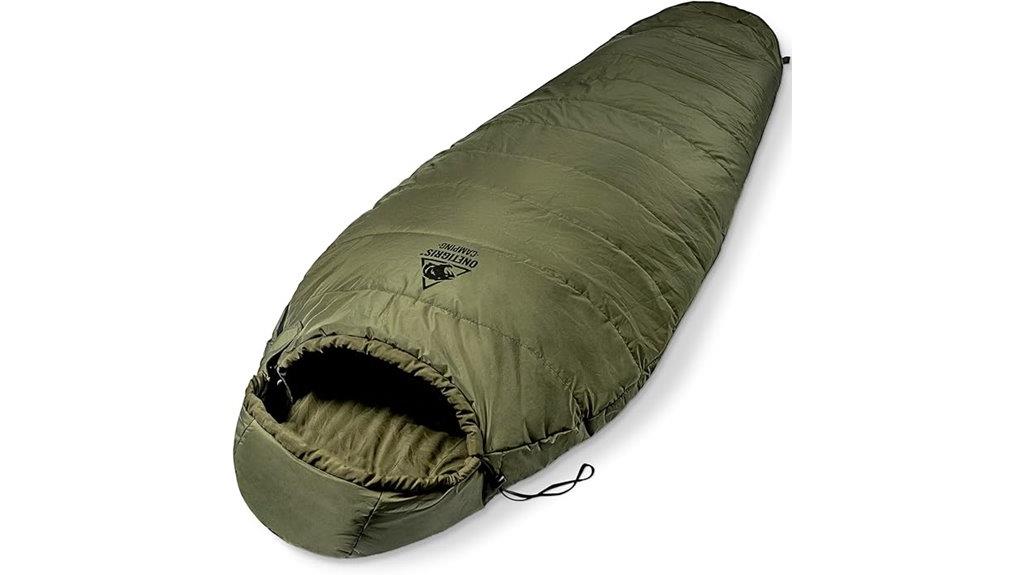
Budget-conscious thru-hikers will find exceptional value in the OneTigris Bushcrafter’s Mummy Sleeping Bag, which delivers reliable 3-season performance at a fraction of the cost of premium models. This mummy-style bag handles temperatures between 46.4-59°F effectively. The 7oz polycotton insulation provides warmth while maintaining breathability. You’ll appreciate the 300T pongee outer shell‘s splash resistance and the 190T pongee lining’s comfort against skin. At 3.1 pounds, it’s heavier than ultralight options but compresses into a manageable 7.8″×16.5″ stuff sack. Quality YKK zippers resist snagging, while the adjustable hood blocks drafts. Users report satisfactory performance even at 30°F, making this bag versatile beyond its rating.
Best For: Budget-conscious campers, hikers, and backpackers seeking reliable 3-season performance without the premium price tag.
Pros:
- Excellent value with reliable performance in temperatures down to 30°F despite being rated for 46-59°F
- Quality construction featuring YKK zippers, splash-resistant outer shell, and machine-washable polycotton materials
- Compresses into a manageable stuff sack (7.8″×16.5″) while maintaining spacious mummy design for comfort
Cons:
- At 3.1 pounds, significantly heavier than ultralight sleeping bags preferred by serious backpackers
- Limited to 3-season use, not suitable for winter camping or extreme cold conditions
- Polycotton fill may not provide the warmth-to-weight ratio of premium down insulation
Factors to Consider When Choosing a Sleeping Bag for a Thru Hike
Choosing the right sleeping bag for your thru-hike requires careful evaluation of five critical factors that’ll determine your comfort and success on the trail. I’ll examine weight and packability constraints, temperature rating requirements for your specific route, insulation type performance differences, durability standards for extended use, and proper sizing considerations. These factors work together to create a sleep system that won’t fail you during months of continuous backcountry use.
Weight and Packability
When you’re carrying every ounce for months across thousands of miles, weight becomes your most critical consideration in selecting a thru-hiking sleeping bag. I recommend prioritizing bags under 2 pounds for warm weather conditions. Some ultralight options weigh as little as 1.7 pounds without sacrificing thermal performance.
Packability matters equally. Your sleeping bag should compress to 11 inches or smaller in height. Look for models with compression stuff sacks that reduce bulk to the size of a Nalgene bottle. This optimization maximizes valuable backpack space.
The key lies in balancing insulation efficiency with weight reduction. Modern synthetic and down insulations maintain warmth while staying lightweight. However, cold-weather bags often sacrifice weight for thermal performance, making them less suitable for long-distance hiking where every ounce counts.
Temperature Rating Requirements
How cold will your nights get? This question determines your sleeping bag’s temperature rating requirements. I recommend matching your bag’s comfort rating to the expected nighttime lows on your route. A 15°F-rated bag suits colder mountain environments, while 55°F ratings work for warmer coastal trails.
For 3-season thru-hiking, bags rated between 30°F and 50°F offer the best versatility. They’ll handle spring’s unpredictable weather, summer’s mild nights, and fall’s dropping temperatures without forcing you to carry multiple bags.
Remember that personal comfort varies greatly. You might need extra layers if temperatures drop below your bag’s rating. Temperature ratings also directly impact insulation type and weight. Down-filled bags rated for extreme cold will be heavier than synthetic bags designed for moderate conditions.
Insulation Type Comparison
Your sleeping bag’s insulation type affects every aspect of your thru-hiking experience, from pack weight to performance in wet conditions. Down insulation delivers superior warmth-to-weight ratio and exceptional compressibility. High-fill power down above 600 maintains loft effectively but demands careful handling in humid environments. It’s your best choice for extreme cold conditions, especially in 0°F-rated bags where down outperforms synthetic alternatives at comparable weights.
Synthetic insulation excels in water resistance and drying speed. It’ll maintain warmth even when damp, making it ideal for wet hiking conditions. Synthetic bags perform consistently across wider temperature ranges and require less maintenance than down. However, they’re heavier and less compressible than down options. Your choice ultimately depends on expected weather conditions, weight priorities, and budget considerations.
Durability and Materials
Demanding thousands of miles of trail abuse, your thru-hiking sleeping bag must withstand constant compression, ground contact, and equipment friction that would destroy lesser gear. Ripstop nylon and polyester fabrics deliver the tear-resistant properties essential for long-distance hiking. These materials combine lightweight characteristics with superior durability ratings.
I prioritize sleeping bags with waterproof outer layers. This protection maintains insulation performance when ground moisture or condensation threatens your warmth. The shell fabric should resist abrasion from rocks, tent floors, and pack contact.
Fill material directly impacts durability expectations. Down insulation offers exceptional warmth-to-weight ratios but loses effectiveness when wet. Synthetic fills provide superior moisture resistance and maintain loft after repeated compression cycles. Consider synthetic options for humid climates or high-precipitation seasons where durability under wet conditions becomes critical.
Size and Fit
Every ounce matters when you’re carrying your shelter system for months across challenging terrain. I recommend choosing a sleeping bag with precise dimensional specifications that match your body measurements. A snug fit minimizes dead air space and heat loss. However, you’ll need adequate shoulder width for side sleepers and sufficient length for your height.
Mummy bags offer the best warmth-to-weight ratio at 1.5-3 pounds, while rectangular designs provide more movement space but weigh 20-30% more. I suggest measuring your shoulder width and adding 4-6 inches for comfort. Tall hikers should select bags with 6’6″ length specifications rather than standard 6’0″ models. The bag must compress to 8-12 liters in your pack while maintaining loft for insulation efficiency.
Waterproof Performance Levels
Water resistance becomes a critical performance factor when moisture threatens your core warmth during extended backcountry travel. I’ll break down waterproof performance levels to help you make informed decisions.
Basic water-resistant bags handle light rain and drizzle effectively. However, they’ll fail during heavy downpours unless specifically engineered for extreme conditions. Look for nylon shells with Durable Water Repellent (DWR) finishes or specialized waterproof membranes for superior protection.
Premium waterproof bags include moisture-wicking linings and sealed seams. These features create extensive barriers against humidity and precipitation. You’ll face a trade-off though: enhanced waterproofing often reduces breathability, potentially causing interior condensation during high-humidity conditions.
Consider your typical hiking environments when selecting waterproof performance levels. Extended exposure to wet conditions demands higher-rated protection systems.
Compressibility Features
Pack size matters just as much as keeping dry when you’re hauling everything on your back for months. I look for sleeping bags that compress below 12 inches in height to maximize backpack real estate. Weight becomes critical on thru-hikes—I target bags weighing 1 to 2 pounds maximum.
Compression sacks make the difference between organized and chaotic packing. Quality bags include dedicated stuff sacks that reduce bulk by 30-40%. The compression ratio tells the real story: a bag’s uncompressed volume divided by its packed size reveals efficiency.
Look for integrated straps or compression systems. These features enable quick setup and breakdown during daily camp routines. The best bags pack small enough to leave room for essential gear while maintaining their insulation properties after repeated compression cycles.
Zipper Quality Standards
When you’re months into a trail and fumbling with a broken zipper in freezing temperatures, you’ll understand why zipper quality separates reliable gear from expensive mistakes. YKK zippers dominate the premium sleeping bag market for good reason. They resist wear and maintain smooth operation after thousands of cycles. Anti-snag designs prevent the frustrating catches that plague cheaper alternatives.
Two-way zippers offer critical versatility. You can vent from the bottom for temperature regulation or fully open the bag as a blanket. This feature also enables coupling with another compatible bag. Proper zipper placement matters equally. Mummy bags with draft tubes behind full-length zippers eliminate cold spots that compromise thermal efficiency. The zipper tape’s width and tooth design directly impact durability and weather resistance.
Frequently Asked Questions
How Often Should I Wash My Sleeping Bag During a Long Thru-Hike?
I recommend washing your sleeping bag every 3-4 weeks during extended thru-hikes. Body oils and sweat reduce insulation efficiency by up to 25% when buildup occurs. Use down-specific detergent at trail towns with front-loading machines. Avoid fabric softeners completely. Air-dry thoroughly before continuing—damp insulation loses 90% of its thermal properties. Between washes, I’ll air out my bag daily and use a sleeping bag liner to extend clean intervals.
Can I Repair a Torn Sleeping Bag While on the Trail?
Yes, I can repair most sleeping bag tears on the trail with the right materials. For down bags, I carry tenacious tape or ripstop repair patches for fabric tears. Small holes need seam sealer applied immediately. Synthetic bags handle repairs better since moisture won’t compromise insulation. I pack a needle, thread, and fabric patches for major tears. Quick fixes prevent further damage until proper repairs.
What’s the Difference Between Down and Synthetic Insulation for Thru-Hiking?
I’ll break down the key differences for you. Down insulation provides superior warmth-to-weight ratios and compresses smaller, making it ideal for ultralight thru-hiking. However, it loses insulation when wet and costs more. Synthetic insulation retains warmth when damp and dries faster, but weighs more and packs larger. For most thru-hikes, I recommend down with proper waterproofing unless you’re hiking in consistently wet conditions.
How Do I Prevent My Sleeping Bag From Getting Wet in Rain?
I’ll recommend three proven methods to keep your sleeping bag dry. First, use a waterproof stuff sack or dry bag rated IPX7 or higher. Second, store it inside your pack’s main compartment, not external attachment points. Third, apply durable water repellent treatment annually to restore fabric protection. These strategies prevent moisture infiltration that destroys insulation performance and creates hypothermia risks.
Should I Bring a Sleeping Bag Liner for Additional Warmth?
I recommend bringing a liner for shoulder-season hiking when temperatures drop unexpectedly. Silk liners add 5-10°F warmth while weighing only 2-4 ounces. Synthetic liners provide 10-15°F boost but weigh 6-8 ounces. You’ll also extend your bag’s lifespan since liners protect against body oils and dirt. Skip liners during summer hiking unless your bag’s too warm for conditions.
On a final note
I’ve covered eight top-performing sleeping bags that deliver the weight-to-warmth ratio you need for successful thru-hiking. Each bag offers specific temperature ratings, weight specifications, and compression capabilities that directly impact your trail performance. You’ll find options ranging from ultralight warm-weather designs to robust cold-weather mummy bags. Select based on your planned hiking seasons, personal sleep temperature preferences, and pack weight limitations. Your comfort depends on matching these technical specifications to your specific trail conditions.

